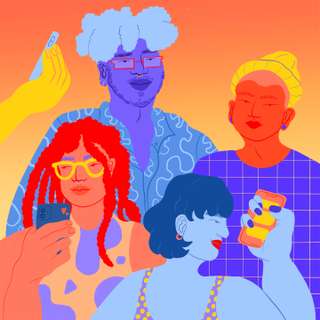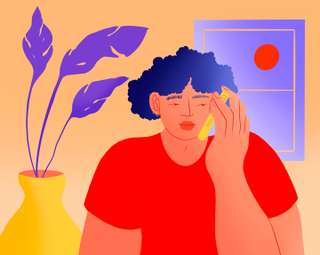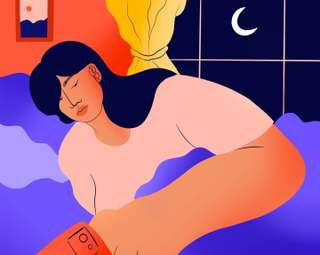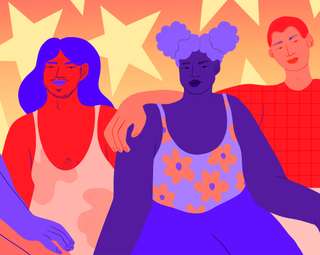Introduction
The Trevor Project’s 2022 National Survey on LGBTQ Youth Mental Health demonstrates that rates of suicidal thoughts have trended upward among LGBTQ young people over the last three years, making our life-saving work all the more important.
Capturing the experiences of nearly 34,000 LGBTQ youth ages 13 to 24 across the United States, with 45% of respondents being LGBTQ youth of color and 48% being transgender or nonbinary, our fourth annual national survey is one of the most diverse surveys of LGBTQ youth ever conducted.
These data provide critical insights into some of the unique suicide risk factors faced by LGBTQ youth, top barriers to mental health care, and the negative impacts of COVID-19 and relentless anti-transgender legislation. This research also highlights several ways in which we can all support the LGBTQ young people in our lives—and help prevent suicide.
It’s essential to emphasize that we still do not have known counts or registries of the LGBTQ youth population—and comprehensive, intersectional data on LGBTQ youth mental health outcomes remain limited. So our annual national survey strives to fill in these gaps and amplify the experiences of young LGBTQ people, a marginalized group consistently found to be at significantly increased risk for suicide because of how they are mistreated and stigmatized in society.
We hope these data and trends will be used by fellow researchers, policymakers, and youth-serving organizations to advance policies and practices that better support LGBTQ youth around the globe and work to end the public health crisis of suicide.
Over the next year, The Trevor Project will release new data from this diverse, national sample in the form of research briefs and research reports on a wide variety of topics related to LGBTQ youth mental health and suicide prevention. And as always, we will continue to do all we can to advocate for LGBTQ-inclusive policies, raise public awareness and acceptance, and be there for every single LGBTQ young person who needs help or support, 24/7.
Amit Paley (he/him)
CEO & Executive Director

Want to help support The Trevor Project?
Your donation helps to support future, meaningful research about LGBTQ youth and power the life-saving services we provide.
DonateKey Findings
45% of LGBTQ youth seriously considered attempting suicide in the past year.
Nearly 1 in 5 transgender and nonbinary youth attempted suicide and LGBTQ youth of color reported higher rates than their white peers.
LGBTQ youth who felt high social support from their family reported attempting suicide at less than half the rate of those who felt low or moderate social support.
Fewer than 1 in 3 transgender and nonbinary youth found their home to be gender-affirming.
LGBTQ youth who found their school to be LGBTQ-affirming reported lower rates of attempting suicide.
60% of LGBTQ youth who wanted mental health care in the past year were not able to get it.
LGBTQ youth who live in a community that is accepting of LGBTQ people reported significantly lower rates of attempting suicide than those who do not.
Mental Health & Suicide Risk:
Suicide Risk
45% of LGBTQ youth seriously considered suicide in the past year
including more than half of transgender and nonbinary youth and 1 in 3 cisgender youth.
14% of LGBTQ youth attempted suicide in the past year
including nearly 1 in 5 transgender and nonbinary youth and 1 in 10 cisgender youth.
Rates of considered and attempted suicide among LGBTQ youth
Explore Data by:
-
Ages 13-17
-
Ages 18-24
-
Gay
-
Lesbian
-
Bisexual
-
Pansexual
-
Queer
-
Questioning
-
Asexual
-
Cisgender boy/
man -
Cisgender girl/
woman -
Transgender boy/
man -
Transgender girl/
woman -
Nonbinary/
genderqueer -
Questioning
-
Asian American/
Pacific Islander -
Black
-
Latinx
-
Middle Eastern/
Northern African -
Native/
Indigenous -
White
-
More than one race/
ethnicity
12% of white youth attempted suicide in the past year
compared to…
-
21%
of Native/
Indigenous youth -
20%
of Middle Eastern/
Northern African youth - 19% of Black youth
- 17% of Multiracial youth
- 16% of Latinx youth
-
12%
of Asian American/
Pacific Islander youth
Although our data continue to show high rates of mental health and suicide risk among LGBTQ young people, it is crucial to note that these rates vary widely based on the way LGBTQ youth are treated.
Dr. Myeshia Price (she/her or they/them)
Senior Research Scientist, The Trevor Project
Anxiety & Depression
73% of LGBTQ youth reported experiencing symptoms of anxiety
including more than three-quarters of transgender and nonbinary youth and nearly two-thirds of cisgender youth.
58% of LGBTQ youth reported experiencing symptoms of depression
including nearly two-thirds of transgender and nonbinary youth and nearly half of cisgender youth.
Anxiety & depression symptoms reported among LGBTQ youth
Explore Data by:
-
Ages 13-17
-
Ages 18-24
-
Gay
-
Lesbian
-
Bisexual
-
Pansexual
-
Queer
-
Questioning
-
Asexual
-
Cisgender boy/
man -
Cisgender girl/
woman -
Transgender boy/
man -
Transgender girl/
woman -
Nonbinary/
genderqueer -
Questioning
-
Asian American/
Pacific Islander -
Black
-
Latinx
-
Middle Eastern/
Northern African -
Native/
Indigenous -
White
-
More than one race/
ethnicity
Trends in LGBTQ youth mental health & suicide risk from 2020 to 2022
-
Symptoms of anxiety
-
Symptoms of depression
-
Considered suicide
-
Attempted suicide
Mental Health Care:
Access to Care
Among all LGBTQ youth, 82% wanted mental health care and 18% did not.
60% of LGBTQ youth who wanted mental health care in the past year were not able to get it
including nearly 3 in 5 transgender and nonbinary youth and more than 3 in 5 cisgender youth.
Desire for and access to mental health care
Access to mental health care
-
60% Wanted but did not receive care
-
40% Wanted and received care
LGBTQ youth who wanted mental health care but were unable to get it cited the following top ten reasons
LGBTQ youth who did not feel care providers would understand their culture by race/ethnicity
Impact of Current Events:
COVID-19
56% of LGBTQ youth reported that their mental health was poor most of the time or always due to the COVID-19 pandemic
including more than 3 in 5 transgender and nonbinary youth and nearly half of cisgender youth.
LGBTQ youth who reported that their mental health was “poor” most of the time or always due to the COVID-19 pandemic
LGBTQ youth who reported a close family member or friend died due to COVID-19 by race/ethnicity
Anti-Transgender Legislation
93% of transgender and nonbinary youth said that they have worried about transgender people being denied access to gender-affirming medical care due to state or local laws.
91% of transgender and nonbinary youth said that they have worried about transgender people being denied access to the bathroom due to state or local laws.
83% of transgender and nonbinary youth said that they have worried about transgender people being denied the ability to play sports due to state or local laws.
Recent political attacks aimed at transgender and nonbinary youth have not only threatened their access to health care, support systems, and affirming spaces at school, they’ve also negatively impacted their mental health.
Dr. Jonah DeChants (he/him)
Research Scientist, The Trevor Project
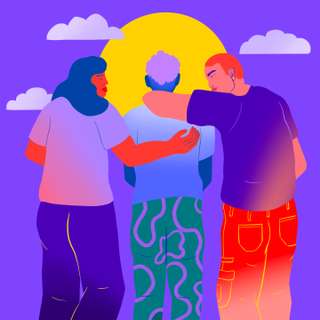
Unique Challenges
LGBTQ youth who experienced anti-LGBTQ victimization — including being physically threatened or harmed, discriminated against, or subjected to conversion therapy — reported more than twice the rate of attempting suicide in the past year compared to those who did not have any of these anti-LGBTQ experiences.
Unique Challenges:
Physical Harm
36% of LGBTQ youth reported that they have been physically threatened or harmed due to either their sexual orientation or gender identity.
31% of LGBTQ youth reported that they have been physically threatened or harmed due to their sexual orientation.
37% of transgender and nonbinary youth reported that they have been physically threatened or harmed due to their gender identity.
We must recognize that LGBTQ young people face stressors simply for being who they are that their peers never have to worry about.
Amit Paley (he/him)
CEO & Executive Director, The Trevor Project
Rates of LGBTQ youth who have been physically threatened or harmed
Rates of LGBTQ youth who have been physically threatened or harmed by race/ethnicity
-
Asian American/
Pacific Islander -
Black
-
Latinx
-
Middle Eastern/
Northern African -
Native/
Indigenous -
White
-
More than one race/
ethnicity
LGBTQ youth who attempted suicide in the past year, comparison across those who have ever been physically threatened or harmed due to either their sexual orientation or gender identity
Discrimination
73% of LGBTQ youth reported that they have experienced discrimination based on their sexual orientation or gender identity at least once in their lifetime.
65% of LGBTQ youth reported that they have experienced discrimination based on their sexual orientation.
71% of transgender and nonbinary youth reported that they have experienced discrimination based on their gender identity.
Rates of LGBTQ youth who have experienced discrimination
Rates of LGBTQ youth who have experienced discrimination by race/ethnicity
-
Asian American/
Pacific Islander -
Black
-
Latinx
-
Middle Eastern/
Northern African -
Native/
Indigenous -
White
-
More than one race/
ethnicity
LGBTQ youth who attempted suicide in the past year, comparison across those who have ever experienced discrimination
Conversion Therapy
LGBTQ youth who reported being threatened with or subjected to conversion therapy
-
83% Not subjected to or threatened with conversion therapy
-
11% Threatened with conversion therapy
-
6% Subjected to conversion therapy
17% of LGBTQ youth reported being threatened with or subjected to conversion therapy
including more than 1 in 5 transgender and nonbinary youth and more than 1 in 10 cisgender youth.
Conversion therapy has been consistently associated with negative mental health outcomes and greater risk for suicide. That’s why this so-called ‘therapy’ is widely opposed by all major medical and mental organizations, and why it is a major focus of The Trevor Project’s advocacy work.
Amit Paley (he/him)
CEO & Executive Director, The Trevor Project
LGBTQ youth who attempted suicide in the past year, comparison across those subjected to conversion therapy
Ways to Support LGBTQ Youth:
Access to Affirming Homes & Schools
LGBTQ youth who live in a community that is accepting of LGBTQ people reported significantly lower rates of attempting suicide compared to those who do not.
Nearly 2 in 5 LGBTQ youth reported living in a community that is somewhat or very unaccepting of LGBTQ people.
LGBTQ youth who identified home or school as an LGBTQ-affirming space
Transgender and nonbinary youth who identified home or school as a gender-affirming space
LGBTQ youth who attempted suicide in the past year, comparison across access to LGBTQ-affirming spaces
-
Not LGBTQ-affirming
-
LGBTQ-affirming
Transgender and nonbinary youth who attempted suicide in the past year, comparison across access to gender-affirming spaces
-
Not gender-affirming
-
Gender-affirming
These findings emphasize the wide range of experiences and identities held by LGBTQ young people across the country, as well as the clear need to break down barriers to care and promote acceptance at the local level to help save young LGBTQ lives.
Dr. Myeshia Price (she/her or they/them)
Senior Research Scientist, The Trevor Project
Reports of community acceptance of LGBTQ people among LGBTQ youth
Suicide attempt rate by community acceptance of LGBTQ people
The Importance of LGBTQ Representation & Advocacy
89%
of LGBTQ youth reported that seeing LGBTQ representation in TV/
LGBTQ youth also reported feeling good about being LGBTQ when…
- 79% musicians come out as LGBTQ
- 74% other celebrities come out as LGBTQ
- 71% non-LGBTQ celebrities advocate for LGBTQ people
- 70% companies are led by LGBTQ people
- 67% athletes come out as LGBTQ
Support from Parents & Caregivers
Five most common ways that LGBTQ youth reported feeling supported by their parents or caregivers
The fact that very simple things — like support from family and friends, seeing LGBTQ representation in media, and having your gender expression and pronouns respected — can have such a positive impact on the mental health of an LGBTQ young person is inspiring, and it should command more attention in conversations around suicide prevention and public debates around LGBTQ inclusion.
Amit Paley (he/him)
CEO & Executive Director, The Trevor Project
Suicide attempt rate by LGBTQ youth social support
-
Low to moderate support
-
High support
LGBTQ youth reported lower rates of attempting suicide when they felt more supported by their friends and family.
Where did LGBTQ youth find moments of joy?
Although LGBTQ youth reported many serious challenges, they also described hundreds of ways in which they find joy and strength in their lives. From their favorite content and activities to seeing representation and allyship, the wide range of responses emphasizes that we can all help create safe, supportive environments where LGBTQ youth can feel happy and express themselves.
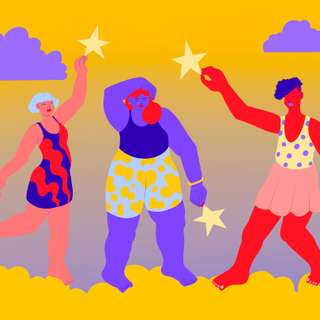
- BTS & Lil Nas X
- wearing my first binder
- Dungeons & Dragons
- seeing LGBTQ people of color represented in media
- going to drag shows
- getting to take care of house plants
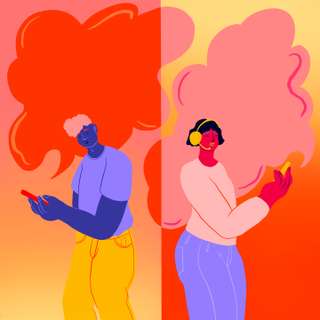
- journaling my thoughts and feelings
- watching anime
- K-Pop
- changing my name to something that fit me
- having a doctor who is an ally
- my determination
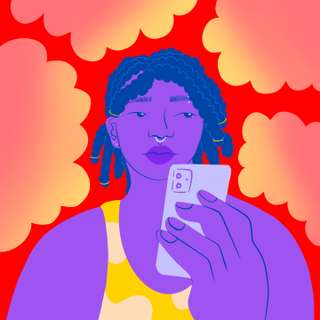
- my cat
- writing songs
- daydreaming about the future
- happy LGBTQ elders
- loving my body
- just knowing that there’s people out there like me
- Therapy & medication
- Gender-affirming clothing
- Family & parental support
- The LGBTQ community
- Accepting & affirming friends
- Hope & excitement for the future
- Happy LGBTQ elders & married couples
- Online communities & support
- Learning about LGBTQ history
- Faith & spirituality
- Music (BTS, Lil Nas X, etc)
- Partners/
falling in love - Cishet allies
- Learning I’m not alone and there are more people like me
- Protective laws/
victories for LGBTQ rights - Supportive teachers
- Having a safe space to express gender, gender identity, and sexuality
- All gender restrooms
- Queer role models
- Pets/
Animals - Taking care of younger siblings
- Art, art expression, art therapy/
crafting/ drawing - Video games/
gamer community - LGBTQ clubs on campus
- Athletics & Exercise
- Going to college
- Drag shows
- Dance
- Living as their authentic self
- Escapism/
fantasy/ fandom - Gender-affirming hormones
- Financial stability
- LGBTQ celebrities, influencers & representation in media
- Self-love & acceptance
- Cooking
Methodology
The content and methodology for The Trevor Project’s 2022 National Survey on LGBTQ Youth Mental Health were approved by an independent Institutional Review Board.
A quantitative cross-sectional design was used to collect data through an online survey platform between September 20 and December 31, 2021. A sample of individuals ages 13 to 24 who resided in the United States was recruited via targeted ads on social media. No recruitment was conducted via The Trevor Project’s website or social media channels. Respondents were defined as being LGBTQ if they identified with a sexual orientation other than straight/heterosexual, a gender identity other than cisgender, or both. In order to ensure the representativeness of the sample, targeted recruitment was conducted to ensure adequate sample sizes with respect to geography, gender identity, and race/ethnicity. Qualified respondents completed a secure online questionnaire that included a maximum of 143 questions. Questions on considering and attempting suicide in the past year were taken from the Centers for Disease Control and Prevention’s Youth Risk Behavior Survey to allow for comparisons to their nationally representative sample. Each question related to mental health and suicide was preceded by a message stating, “If at any time you need to talk to someone about your mental health or thoughts of suicide, please call The Trevor Project at 1-866-488-7386.”
Although 114,288 individuals from unique IP addresses began the survey, 30,976 did not complete the initial demographic screening questions, and 38,484 were screened out based on ages outside of the sample range and residency outside of the United States. This resulted in an eligible sample of 44,828 LGBTQ youth ages 13-24. A validity check was placed midway through the survey which asked participants to select “agree” from a five-point statement with answers ranging from “strongly disagree” to “strongly agree.” Youth who did not select “agree” (n=918) or who did not reach the validity question in the mid-point of the survey (n=9506) were removed from the analytic sample. Additionally, 194 indicated that they weren't honest in their responses, and 217 were identified as mischievous responders based on written responses. This resulted in a final analytic sample of 33,993 LGBTQ youth ages 13 to 24 who resided in the United States.
This report uses “transgender and nonbinary” as an umbrella term to encompass non-cisgender youth, which includes young people who identify as transgender and nonbinary as well as other labels outside of the cisgender binary, including genderqueer, agender, genderfluid, gender neutral, bigender, androgynous, and gender non-conforming, among others.
Comparability
In order to better understand how our sample compares to a national probabilistic sample, we included questions regarding considering and attempting suicide that were identical to those used by the Centers for Disease Control and Prevention (CDC) in their Youth Risk Behavior Surveillance System (YRBS).
Analyses were conducted to compare rates of seriously considering suicide and attempting suicide in the past 12 months among youth ages 13 to 18 in our sample to the 2019 YRBS sample of lesbian, gay, and bisexual (LGB) high school students.
YRBS prevalence rates among LGB youth for seriously considering suicide (47%) were comparable to rates among the same age range in our sample (49%).
Additionally, 23% of LGBT youth in the 2019 YRBS reported a suicide attempt in the past 12 months compared to 17% in our sample of youth ages 13-18.
-
Most recent (2019) CDC YRBS Survey
-
2022 Trevor Project Survey (ages 13 to 18)
Sample Breakdown of Respondents’ Demographics
By age
-
62% 13 to 17
-
38% 18 to 24
By sexual orientation
-
1% Straight or Heterosexual
-
12% Gay
-
13% Lesbian
-
31% Bisexual
-
20% Pansexual
-
10% Queer
-
4% Questioning
-
9% Asexual
By gender identity
-
29% Girl or Woman
-
25% Boy or man
-
37% Nonbinary, bigender, genderfluid, or genderqueer
-
9% Not sure or questioning
By transgender & nonbinary identity
-
33% Cisgender
-
19% Questioning if transgender or nonbinary
-
48% Transgender or nonbinary
By race/ethnicity
-
1% Middle Eastern/Northern African
-
1% Native/Indigenous
-
5% Asian American/Pacific Islander
-
7% Black
-
17% Latinx
-
14% More than one race/ethnicity
-
55% White
By socioeconomic status
-
80% More than meets basic needs
-
20% Just meets basic needs or less
By region
-
16% Northeast
-
34% South
-
23% Midwest
-
27% West
